|

Toyozo Shiryoukan
Arakawa Toyozo's Commemorative Museum
352 Kukuri, Kani-city, Gifu Prefecture, 509-0224
Telephone: 0574-64-1461
Located a short drive from Toki station. Only open on
Friday and weekends from 10:00am to 4:00pm.
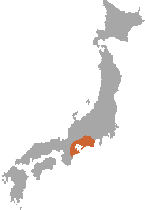 Arakawa Toyozo is a name that speaks volumes in Japan. He, along with Kato Tokuro, is responsible for the revival and current success of the Mino kilns. Mino was the name of the old province which now is located in Gifu prefecture centering around the potting towns of Tajimi and Toki. Today Mino refers to pottery styles that include Shino, Oribe, Ki-Seto (Yellow Seto), and Setoguro (Black Seto). Visit our GUIDEBOOK to learn more about Mino styles. Arakawa Toyozo is a name that speaks volumes in Japan. He, along with Kato Tokuro, is responsible for the revival and current success of the Mino kilns. Mino was the name of the old province which now is located in Gifu prefecture centering around the potting towns of Tajimi and Toki. Today Mino refers to pottery styles that include Shino, Oribe, Ki-Seto (Yellow Seto), and Setoguro (Black Seto). Visit our GUIDEBOOK to learn more about Mino styles.
Arakawa was born in Tajimi in Meiji 27 (1894). He had a prolific career working at the kiln of Miyanaga Tozan in Kyoto and then for Rosanjin in Kamakura. He established his own kiln in 1933 and this is how the story goes.
Having been born in the Mino region he had a special affection for Shino pottery. Up until then Shino was thought to have been fired in the Momoyama period in Seto, not far from Tajimi but located in Aichi prefecture. In the book, 'Visiting The Mino Kilns' by Janet Barriskill, she translated the words of Arakawa thus:
My thoughts go back to that time in the fourth month of the fifth year of Showa (April 1930) when I discovered the ruins of the old kiln at Ogaya; it was at the time of the Nagoya exhibition by the Hoshigaoka kiln of Kitaoji Rosanjin. In Nagoya, I had the opportunity to see a cylindrical teabowl - decorated with a bamboo shoot- owned by the Sekido family. On the base of this teabowl featuring a bamboo-shoot motif drawn with the utmost simplicity, I could clearly see a red fire-coloured mark on the area where the hamagoro (circular fireclay pad used to separate the pot from the saggar during firing) had been placed. Looking closely, I noticed a small piece of clay adhering to this area; it was decidedly red in colour. Up until then it was commonly thought that this pot had been fired at the Seto kilns, but to me, this did not appear to be Seto clay.
That encounter was to change the history of Japanese pottery. Arakawa knew that in the hills outside Toki there was clay of that color. So the next day he trekked out to the old Momoyama kiln sites and excavated a shard with the exact same motif as the Sekido teabowl - he was ecstatic!
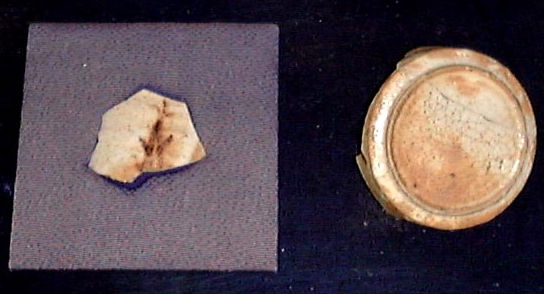 |
That was at the old Mutabora kiln site, the place where Arakawa built his own kiln in 1933 (below photo shows entrance road to site).
A small stone monument has been erected at the site where he found the shard and the below picture shows it along with the great potter Yoshida Yoshihiko who was an apprentice to Arakawa for thirteen years.
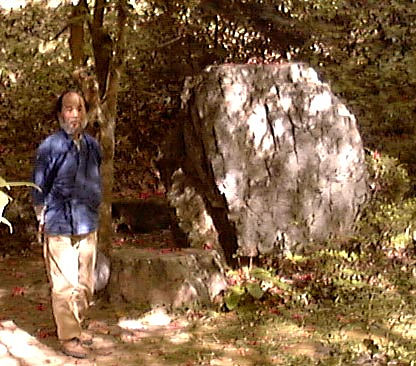 |
As a side note, no other bamboo shoot motif shard has been discovered to date - surely the pottery Gods were looking over Arakawa that fateful day in 1930.
A few other monuments are erected on the premises and a very touching one is dedicated to his wife, it's called Ki-Seto tsubo (jar). Arakawa's was married in 1911 - his bride was only thirteen. She passed away in 1968 and Arakawa made a Ki-Seto urn for her. On the monument he writes of all the hardships she had to endure (there were many years of poverty) without ever complaining, always being supportive. He goes on to say that without her he could have done nothing and the only thing that he can do now is make this Ki-Seto tsubo for her.
Arakawa fired his Mino wares in a kiln very much like those of the Momoyama potters, a half underground anagama.
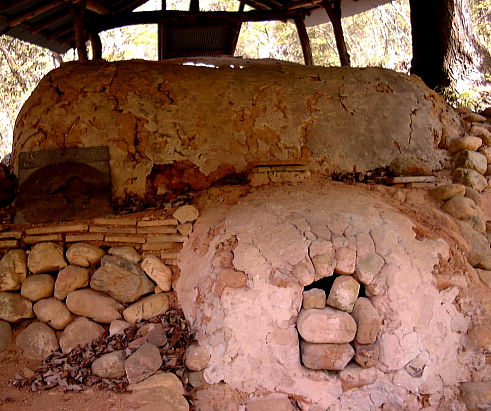 |
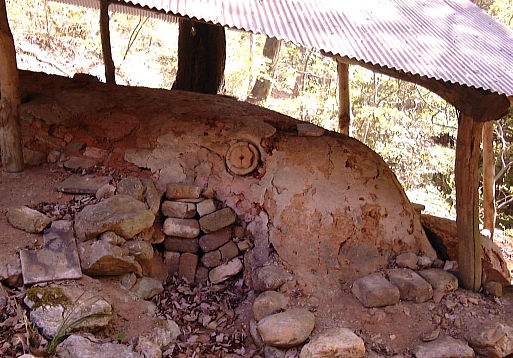 |
The kiln was quite small and could only hold a few dozen pieces with only a handful of Setoguro stratigically placed near the spy holes to be pulled out at the height of firing. The museum is located next to the kiln, as are his home and workshop.
It is a magical place, set in a forest and highlighted in a National Geographic video about the Living National Treasures of Japan (thanks Gene). The buildings are falling into disrepair though and I do hope that some funds are made available to restore them. I took this lonely photo (below) at the front door of his home just thinking about all the great potters and artists who had sat on the bench sipping tea and talking with Arakawa.
In 1955, he was designated a juuyou-mukei-bunkazai, more commonly called a ningen kokuho or 'living national treasure' for his Shino and Setoguro. (Below photo is Shino piece)
The museum is not that large, only one room that houses Arakawa's work, collection, shards, fabulous drawings and other reference materials.
It opened in 1984 when Arakawa was 91 years old; he passed away the next year.
Click here to see a photo tour of Arakawa's work.
|